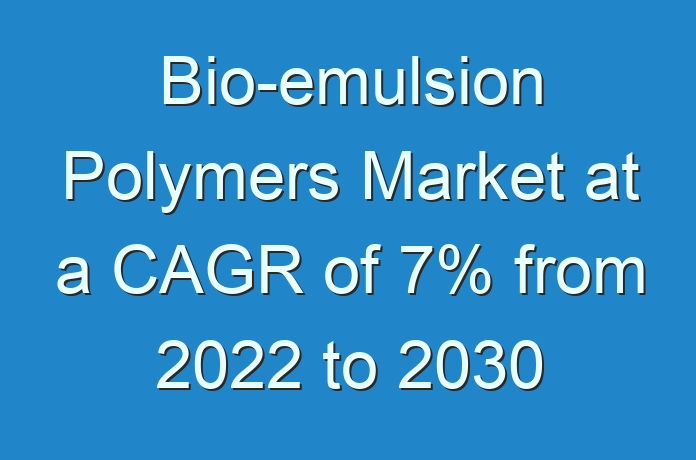
Bio-emulsion Polymers Market: Introduction
The global bio-emulsion polymers market was valued at US$ 900 Mn in 2019 and is anticipated to expand at a CAGR of 7% from 2020 to 2030. Rise in demand for bio-emulsion polymers in the paints & coatings application is driving the global bio-emulsion polymers market. Europe accounted for a significant share of the global bio-emulsion polymers market in 2019. The bio-emulsion polymers market in the region is expected to expand at a CAGR of more than 7.5% during the forecast period. In terms of value, the bio-emulsion polymers market in Asia Pacific is anticipated to expand at a rapid pace of more than 7.6% by the end of the forecast period.
Prominent Trends in Bio-emulsion Polymers Market
The growth in consumer preference for low emission coatings, owing to the increase in awareness about the health effects of volatile organic compounds (VOCs) in chemical products, has led to a shift toward greener coating solutions across the globe. Furthermore, painters are increasingly preferring wall paints with lower VOC and toxicity content in coating formulations. Environmental agencies in the European Union and the U.S. have enacted volatile organic content (VOC) limits for various range of products (including coatings). Rise in demand for greener alternatives and increase in stringent regulations on coatings with higher VOC content are driving manufacturers operating in the paints & coatings industry toward introduction of new greener products.
Request PDF Brochure –
https://www.transparencymarketresearch.com/sample/sample.php?flag=B&rep_id=77919
Thus, the market for bio-based products and bio-based polymer emulsions is expanding at a significant pace. The development of waterborne coatings has been a major step toward sustainable coatings in order decrease potential health hazards related to the use of conventional paints and coatings. Major portion of resin components are used in waterborne coating formulations in acrylic waterborne paints. These alkyd resins are made of petroleum-based sources. This has been hampering the development of completely environment-friendly coatings.
REQUEST FOR COVID19 IMPACT ANALYSIS –
https://www.transparencymarketresearch.com/sample/sample.php?flag=covid19&rep_id=77919
Koninklijke DSM N.V. launched a revolutionary product under the brand name ‘Decovery’ in order to replace these fossil-based components in paints & coatings formulations. The company’s portfolio of Decovery resins are made of seeds, tree bark, corn, castor beans, and other agricultural waste. These resins are made with 49% plant content, with reduction of CO2 emissions by up to 34%.
Buy Now :
https://www.transparencymarketresearch.com/checkout.php?rep_id=77919<ype=S
Drivers of Bio-emulsion Polymers Market
The global paints & coatings market is primarily driven by advancements in the building & construction industry. Growth in the number of upcoming commercial buildings across the globe is projected to propel the global paints & coatings industry. Additionally, the paints & coatings sector is likely to expand due to the increase in reconstruction and renovation activities in the construction sector. Thus, expansion in the paints & coatings industry is likely to propel the global bio-emulsion polymers market.
Enquiry Before Buying :
https://www.transparencymarketresearch.com/sample/sample.php?flag=EB&rep_id=77919
However, the spread of coronavirus across the globe is expected to hamper the paints & coatings market. Several experts are forecasting a V-shaped recession in 2020, akin to the one in 2008. It had lasted for almost two years. The global paints & coatings industry is estimated to recover from 2022. This, in turn, is estimated to propel the demand for bio-emulsion polymers in the near future.
Europe Dominates Bio-emulsion Polymers Market
In terms of value, Europe led the global bio-emulsion polymers market in 2019. Rise in legislation on decreasing the VOC content in paints & coatings formulations by regulatory bodies such as the EPA and REACH is expected to drive the bio-emulsion polymer market in Europe. Furthermore, increase in innovation and technological advancements in the bio-emulsion sector is expected to propel the bio-emulsion polymers market in the region in the near future. The bio-emulsion polymers market in Asia Pacific is projected to expand at a rapid pace during the forecast period. Rise in population and increase in income of the middle class population are anticipated to boost the building & construction sector in the region. This, in turn, is estimated to augment the production and consumption of bio-emulsion polymers in Asia Pacific in the near future.
Share of Prominent Players in Bio-emulsion Polymers Market
Major players operating in the global bio-emulsion polymers market include EcoSynthetix, Inc., Aquapak Polymers Ltd, Plantic Technologies Ltd, Lactips, and Itaconix Corporation. The global bio-emulsion polymers market is highly consolidated. Key companies are focusing on increasing their research and development activities and enhancing the quality of their product portfolio.a





